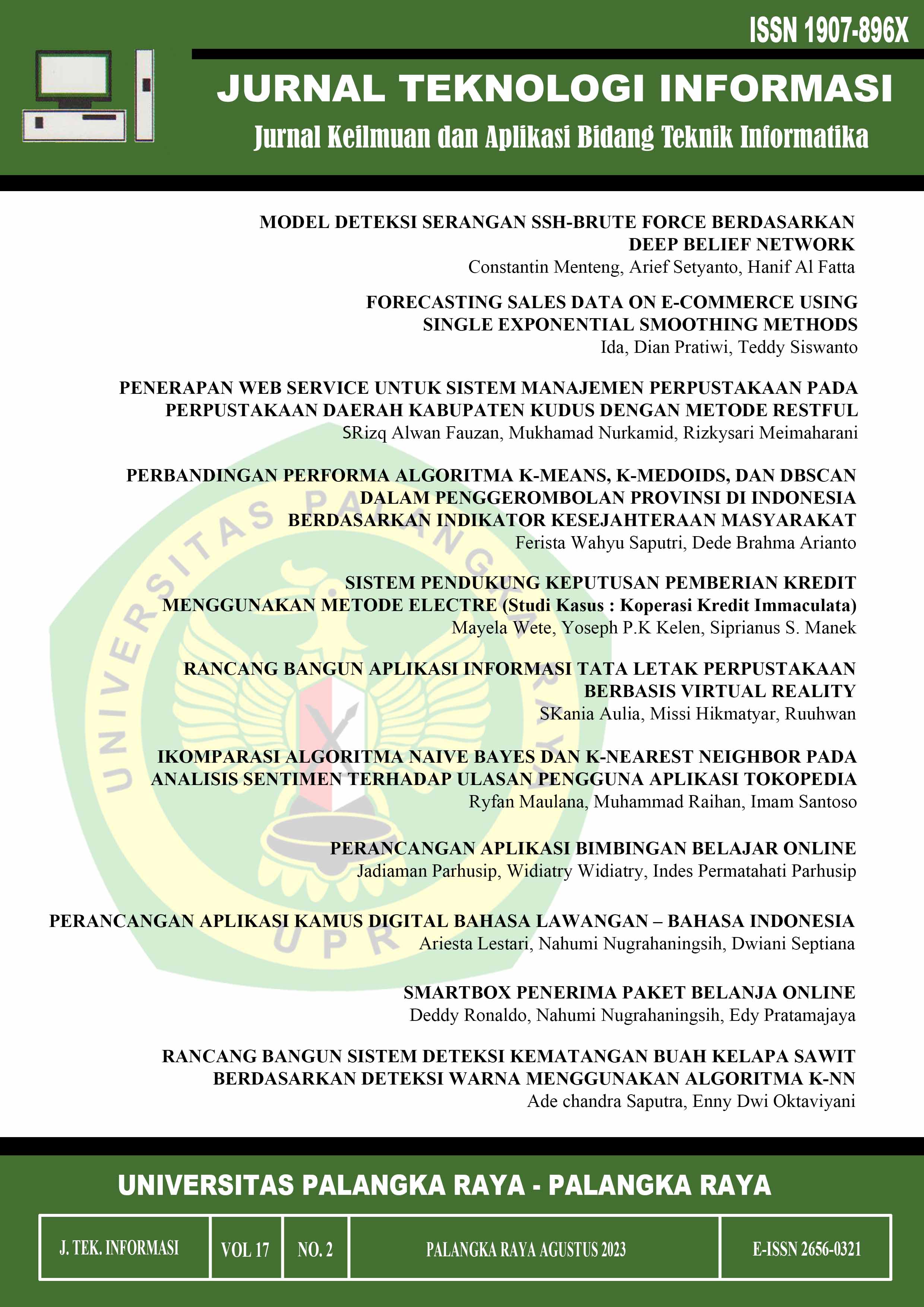MODEL DETEKSI SERANGAN SSH-BRUTE FORCE BERDASARKAN DEEP BELIEF NETWORK
DOI:
https://doi.org/10.47111/jti.v7i2.8151Keywords:
accuracy, Deep belief network, deep model, Restricted Boltzmann MachinesAbstract
Deep Belief Networks are deep learning models that utilize stacks of Restricted Boltzmann Machines (RBM) or sometimes Autoencoders. Autoencoder is a neural network model that has the same input and output. The autoencoder learns the input data and attempts to reconstruct the input data. The solution in this study can provide several tests on DBN such as detecting recall accuracy and better classification precision. By using this algorithm, it is hoped that we as users can overcome problems that occur quite often such as brute force attacks in our accounts and within the company. And the results obtained from this DBN experiment are with an accuracy value of 90.27%, recall 90.27%, precession 91.67%, F1-score 90.51%. The results of this study are the data values of accuracy, recall, precession, and f1-score data used to detect brute force attacks are quite efficient using the deep model of the deep belief network.
Downloads
References
S. K. Wanjau, G. M. Wambugu, and G. N. Kamau, “SSH-Brute Force Attack Detection Model based on Deep Learning,” Int. J. Comput. Appl. Technol. Res., vol. 10, no. 01, pp. 42–50, 2021, doi: 10.7753/ijcatr1001.1008.
M. Courbariaux, Y. Bengio, and J.-P. David, “Low Precision Storage for Deep Learning,” Iclr, no. Section 5, p. 10, 2015, [Online]. Available: http://arxiv.org/abs/1511.00363%5Cnhttp://arxiv.org/abs/1412.7024
Z. Munawa and N. I. Putri, “Keamanan IoT Dengan Deep Learning dan Teknologi Big Data,” Temat. J. Teknol. Inf. Komun., vol. 7, no. 2, pp. 161–185, 2020, [Online]. Available: https://jurnal.plb.ac.id/index.php/tematik/article/view/479
V. No, S. Sandra, and A. Heryanto, “Visualisasi Serangan Brute Force Menggunakan Metode K-Means dan Naïve Bayes,” vol. 2, no. 1, pp. 315–320, 2016.
A. Bimantara, J. S. Komputer, and U. S. Palembang, “Implementasi Machine Learning terhadap Security Management untuk klasifikasi pola traffic TOR pada Intrusion Detection System ( IDS ),” no. Ml.
A. Zainal, A. Assajjad, S. Si, M. Si, and U. N. Wisesty, “Klasifikasi Sinyal EKG Menggunakan Deep Belief Network dengan Restricted Boltzmann Machine,” vol. 5, no. 2, pp. 3623–3630, 2018.
K. R. Kareem Kamoona and C. Budayan, “Implementation of Genetic Algorithm Integrated with the Deep Neural Network for Estimating at Completion Simulation,” Adv. Civ. Eng., vol. 2019, 2019, doi: 10.1155/2019/7081073.
T. Aytaç, M. A. Aydın, and A. H. Zaim, “Detection DDOS attacks using machine learning methods,” Electrica, vol. 20, no. 2, pp. 159–167, 2020, doi: 10.5152/electrica.2020.20049.
S. Priya, “Performance Analysis Comparison on Various Cyber-Attack Dataset By Relating a Deep Belief Network Model on an Intrusion …,” Inf. Technol. Ind., vol. 9, no. 3, pp. 608–613, 2021, [Online]. Available: http://www.it-in-industry.org/index.php/itii/article/view/600
K. Highnam, K. Arulkumaran, Z. Hanif, and N. R. Jennings, “BETH Dataset: Real Cybersecurity Data for Unsupervised Anomaly Detection Research,” CEUR Workshop Proc., vol. 3095, pp. 1–12, 2021.
M. A. Ferrag, L. Shu, H. Djallel, and K. K. R. Choo, “Deep learning-based intrusion detection for distributed denial of service attack in agriculture 4.0,” Electron., vol. 10, no. 11, pp. 1–26, 2021, doi: 10.3390/electronics10111257.
R. Salakhutdinov and I. Murray, “On the quantitative analysis of deep belief networks,” Proc. 25th Int. Conf. Mach. Learn., pp. 872–879, 2008, doi: 10.1145/1390156.1390266.
M. A. Ferrag, L. A. Maglaras, H. Janicke, and R. Smith, “Deep Learning Techniques for Cyber Security Intrusion Detection : A Detailed Analysis,” pp. 126–136, 2019, doi: 10.14236/ewic/icscsr19.16.
S. Manimurugan, S. Al-Mutairi, M. M. Aborokbah, N. Chilamkurti, S. Ganesan, and R. Patan, “Effective attack detection in internet of medical things smart environment using a deep belief neural network,” IEEE Access, vol. 8, pp. 77396–77404, 2020, doi: 10.1109/ACCESS.2020.2986013.
A. Z. Agghey, L. J. Mwinuka, S. M. Pandhare, M. A. Dida, and J. D. Ndibwile, “Detection of username enumeration attack on ssh protocol: Machine learning approach,” Symmetry (Basel)., vol. 13, no. 11, pp. 1–13, 2021, doi: 10.3390/sym13112192.
S. Wali, I. A. Khan, and S. Member, “Explainable AI and Random Forest Based Reliable Intrusion Detection system”.
B. C. Merita, “Penerapan Algoritma Restricted Boltzmann Machine Pada Pemilihan Bidang Minat Mahasiswa Informatika Universitas Muhammadiyah Malang,” J. Repos., vol. 3, no. 2, pp. 207–214, 2021, doi: 10.22219/repositor.v3i2.1204.
M. I. Mohmand, H. Hussain, A. A. L. I. Khan, and M. Haleem, “A Machine Learning based Classification and Prediction Technique for DDoS Attacks,” pp. 1–13, 2017.
M. Scholarworks, “Utilizing Machine Learning Classifiers to Identify SSH Brute Force Attacks Utilizing Machine Learning Classifiers to Identify SSH Brute Force Attacks Advisor : James Deverick,” 2019.
I. Odun-ayo, W. Toro-abasi, M. Adebiyi, O. Alagbe, and I. Odun-ayo, “An implementation of real-time detection of cross-site scripting attacks on cloud-based web applications using deep learning,” vol. 10, no. 5, pp. 2442–2453, 2021, doi: 10.11591/eei.v10i5.3168.
Ismail et al., “A Machine Learning-Based Classification and Prediction Technique for DDoS Attacks,” IEEE Access, vol. 10, pp. 21443–21454, 2022, doi: 10.1109/ACCESS.2022.3152577.
B. Goparaju and S. R. Bandla, “EasyChair Preprint Distributed Denial of Service Attack Classification Using Artificial Neural Networks .,” 2020.












